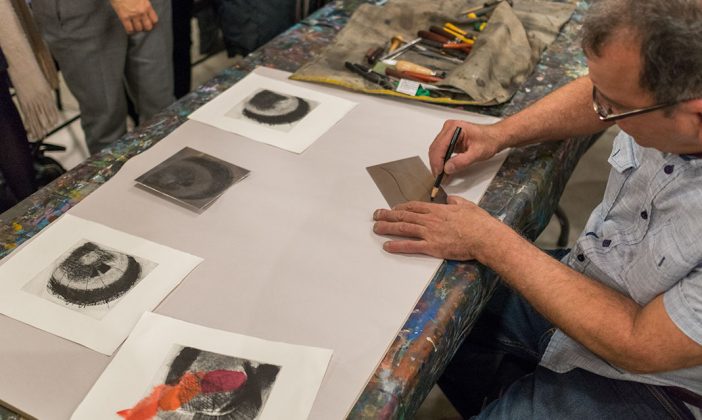Last Friday, VAM opened their doors for their current exhibition’s opening reception. Why do you create? is an interactive show that features both artwork and a workshop by Agustin Rolando Rojas. The exhibition explores the reasons why artists create, including the many people, places, and things that inspire them.
As part of the opening reception, the Cuban-Canadian artist gave an interactive art talk on his creative process. Rojas’ preferred form of art is called drypoint printmaking.
“This, you see, is a dentist tool,” said the enthusiastic Rojas as he held up a sharp metal object. “Yes, it’s a strange object to think about while making art, but this is great for making really sharp lines in the aluminum.”
The process of drypoint printmaking involves an array of tools, each one crucial to providing Rojas’ original look. Rojas sat down at a table and invited the audience to watch as he showed us a sample of how he creates using a small sheet of aluminum.
“Ten centimetres by 10 centimetres, no bigger than my palm. Some people think it’s easier to create on a smaller scale, but I think they’re wrong. For me, it’s very hard. I have to get real close,” Rojas commented as he brought the piece of aluminum up to his face. “Maybe have some coffee and water, because this strains my eyes.” To help him, Rojas used magnifying lenses.
On his table was a pouch filled with an odd assortment of tools some of which were screwdrivers, more dentist tools, metal pieces, sand paper, and old pens.
“Do you have to be strong to create deep lines?” an audience member asked as Rojas scored the aluminum sheet with a dentist tool. “No,” Rojas answered. “I am, but you don’t have to be. The harder you press, the deeper the lines will be, but if you don’t have arm strength or wrist strength, it will just give you a different result.”
He then stood up and brought the audience to a different table to add the ink to the scored aluminum sheet. “The trick is to use this flat tool to make a smooth surface on top of the pot of ink. When I was in second year of university, I dug my tool right in the middle of the ink pot and made a little well. My professor told me to get out of his class until I knew how to properly retrieve ink from the pot. I came back and I did it right,” Rojas explained.
“I smoothed it out on top instead of digging around.” He spread the ink over the aluminum sheet. “Listen to that,” he said, as he brought the aluminum sheet up to his ear and spread the ink around. “That is music to my ears.”
After wiping the excess ink off with old pages from a telephone book, he explained what paper he used. “This is not any old paper. This is cotton paper. It gives the best result. I only like to use the best materials,” he said. “Sure, it costs money, but when I’m done, I find it turns out the best.” Rojas informed the audience that the special cotton paper he uses in the press is a German brand called Hahnemüle.
Rojas then directed his audience to the Takach etching press, the medium-sized paper press that he uses to create his drypoint prints. “You have to wet the cotton paper. I dry it off between two thin sheets of paper.” Rojas brought the damp Hahnemüle paper up to his cheek. “I like to do this because I can test how humid the paper is.”
In the paper press, he placed the inky aluminum sheet face up, and the Hahnemüle paper on top. He laid felt sheets over the top and a metal cylinder rolled over the art with a few cranks of the wheel. The aluminum sheet and cotton paper came out on the other side. He revealed the block of etched lines on cotton paper to the appreciative audience.
His black and white drypoint prints hung proudly on the white wall behind him. “I have won many awards for my art in my 30 years of living here in Canada,” Rojas said. “Each time, I feel proud to represent the country that has done so much for me.”
Why do you create? is on display at Visual Arts Mississauga until December 4.






